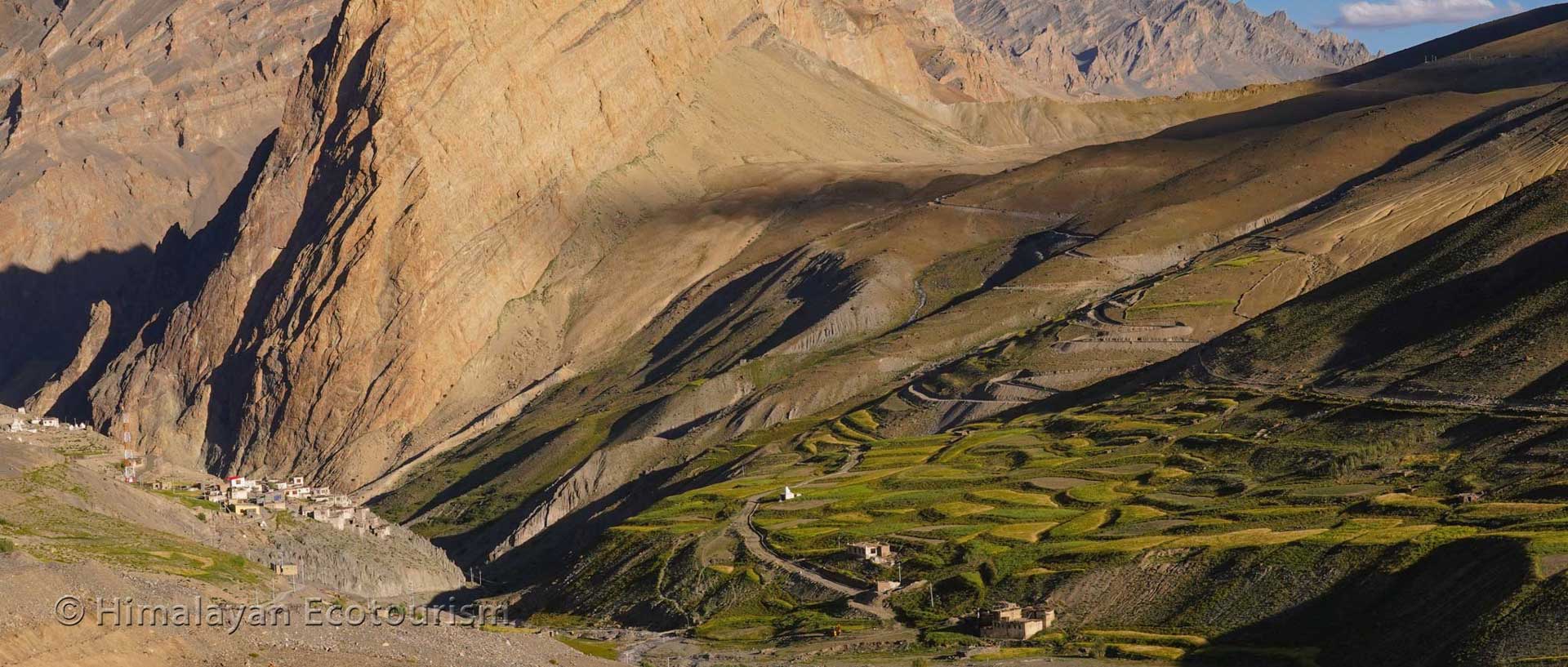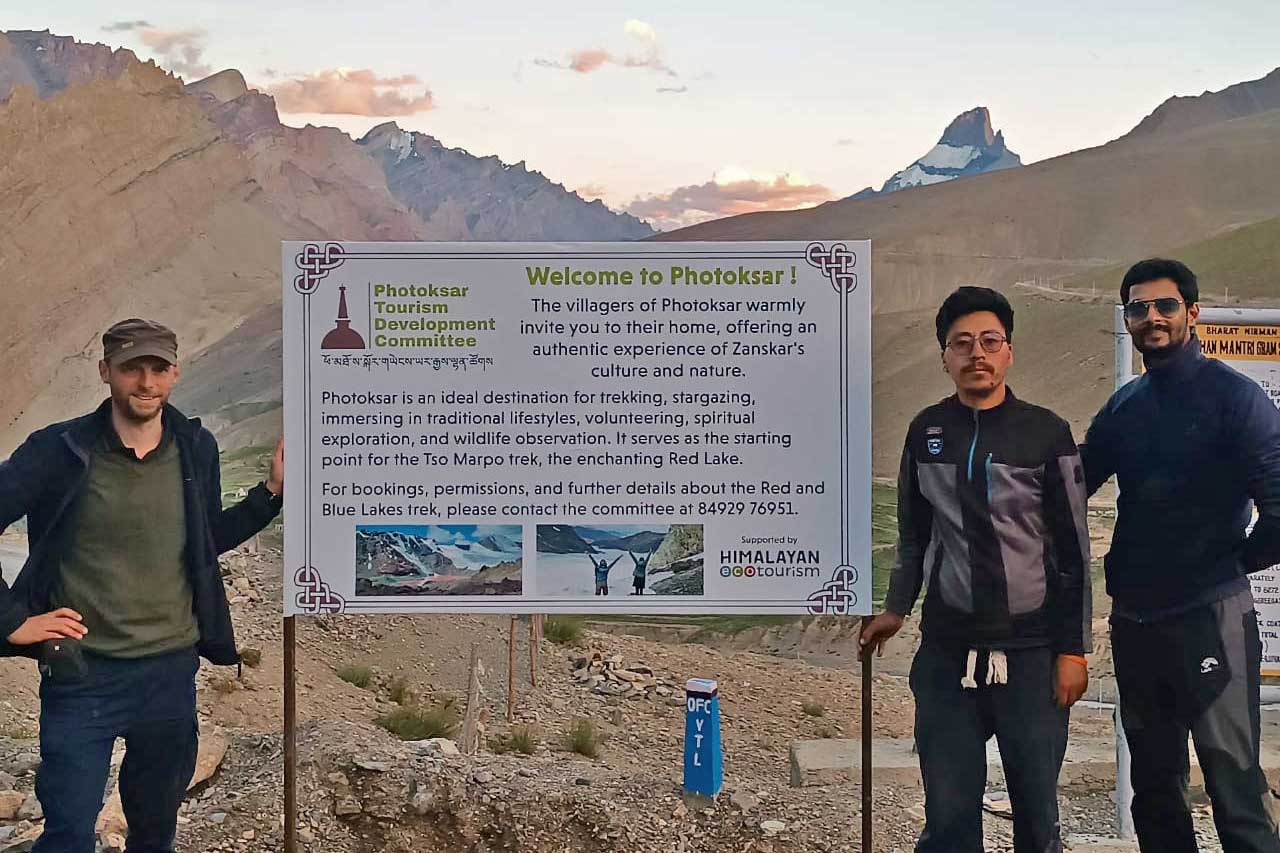Reinventing tourism in Ladakh
By Stephan, founder of Heco and Himalayan Ecotourism
This article led to the writing of “Building a sustainable future : The possible role of enterprises in economic welfare and conservation“
Ladakh – where nature florishes with humans
“Ladakh is truly a marvel on our planet. The landscapes alone are breathtaking, but what makes Ladakh so extraordinary is how its harsh environment has shaped a unique and resilient culture. The villagers have adapted to these extreme conditions through their practice of Tibetan Buddhism and a lifestyle that harmonizes with nature in remarkable ways.
As a conservationist, one aspect of Ladakh that I find particularly inspiring is the symbiotic relationship between humans and nature. Often, we associate human activity with environmental degradation, but in Ladakh, it’s quite the opposite. Here, where there are humans, nature flourishes.
Have you ever noticed how the villages of Ladakh appear like oases amidst the arid mountains? This is largely thanks to the sophisticated irrigation systems the villagers have developed. By diverting water from melting glaciers, they irrigate vast areas around their villages, transforming them into green havens. These lush areas attract a diversity of life— from insects and birds to rodents and larger mammals. The villagers’ grazing animals feed on the grasses in these irrigated zones, and as they move to higher pastures, they enrich the mountainsides with their droppings, enhancing soil fertility. In Ladakh, the presence of humans not only supports but also enriches the local ecosystems.
I not only hope to see the Ladakhi lifestyle endure, but I also believe that in preserving their way of life, we are simultaneously protecting these vital ecosystems, which are increasingly important in the face of global warming.”
The shift in tourism in Ladakh
In recent years, Ladakh has experienced a significant increase in tourism, but unfortunately, much of it has not been beneficial to the region. Historically, Ladakh and Zanskar were popular destinations for international trekkers, who came to experience the unique beauty of this part of the Himalayas. Trekking in “the Little Tibet of India” provided a vital source of income for the residents of remote villages, as these visitors stayed in local homestays, directly supporting the community.
However, the construction of new roads throughout Ladakh has altered this dynamic. The expansion of infrastructure has redirected tourism to more accessible areas, where domestic tourism has rapidly increased. Key destinations such as Leh, Hunder in the Nubra Valley, and Pangong Tso have seen a boom in hotel, restaurant, and shop development, which primarily benefits the already privileged sectors of Ladakhi society. Consequently, rural areas have seen a decline in tourism-related revenue, disrupting their traditional livelihoods.
Consequences
One of the most significant consequences of this shift in tourism is the growing disinterest among the youth in their village life. With fewer economic opportunities and the demanding nature of traditional livelihoods, many young people are increasingly drawn to the allure of city life. The hard work of grazing pashmina goats in the wilderness or tending to barley fields no longer appeals to them. Instead, they aspire to move to nearby cities, pursue education, secure jobs, and embrace the comforts and perceived advantages of a modern, urban lifestyle.
This migration of youth from the villages is leaving the elderly behind to manage everything on their own, which further exacerbates the challenges faced by rural communities. The people of Ladakh, who have inherited a sustainable way of life, are gradually shifting toward the unsustainable practices of the modern, globalized world. This trend threatens not only the cultural heritage of Ladakh but also the delicate ecosystems that have thrived in harmony with human activity for centuries.
Reinventing Tourism in Ladakh
At Himalayan Ecotourism (Heco), we view tourism as a powerful tool to address local issues. Ladakh, in particular, is a region where sustainable tourism can play a crucial role in revitalizing rural communities and preserving traditional ways of life. Our mission is to reintroduce sustainable tourism practices in Ladakh’s villages, ensuring that tourism becomes a force for good.
The approach is straightforward: by attracting the right kind of tourists to these villages, we can provide additional income to the residents and increase the value of village life from the perspective of the youth. When young people see that their villages offer economic opportunities, they may be more inclined to stay and contribute to their communities.
However, the impact of sustainable tourism extends beyond economics. When villagers host travelers who are genuinely interested in discovering and experiencing the local culture, it fosters a sense of pride within the community. These respectful travelers are eager to understand and appreciate the local lifestyle, which positively impacts the villagers’ self-esteem and strengthens cultural identity.
To attract such travelers, it is essential to offer immersive experiences. Our approach emphasizes village lifestyle experiences, such as cultural programs, cooking classes, and explorations of local spirituality, alongside nature-based activities like trekking, camping, stargazing, and wildlife observation.
A Pilot Project in Photoksar
To put this strategy into action, we have launched a pilot project in the village of Photoksar in the Zanskar range. Like many other villages, Photoksar has experienced a sharp decline in visitors since the construction of a road that bypasses the traditional trekking route through the village.
Our key initiative to revitalize tourism in Photoksar is the opening of a new trekking route: the trek to Tso Marpo, the Red Lake, situated at an elevation of over 5,000 meters and accessible only from Photoksar.
To ensure that this trek benefits the village of Photoksar—rather than just commercial operators—and to keep tourism development sustainable, we have encouraged the villagers to unite around this project. As a result, they have established the “Photoksar Tourism Development Committee,” which we actively support.
This committee operates under a model similar to the GHNP cooperative in Himachal Pradesh, that has also been promoted by Himalayan Ecotourism. It has the authority to enforce rules governing the operations of the trek. So far, the committee has decided that trekkers wishing to visit Tso Marpo must spend at least one night in a homestay in Photoksar, pay a fee of INR 200 per day of trekking to the committee, and employ the trekking staff from Photoksar. These measures ensure that the trek to Tso Marpo provides a consistent income to the villagers and the committee, which manages these funds collectively for the benefit of Photoksar.
Tour operators interested in sending their clients to the Red Lake are encouraged to contact Himalayan Ecotourism. We will connect you with the Committee, who will assist in organizing the trek.
Photoksar is just the beginning. This pilot project is part of a larger program that aims to involve more villages across Ladakh, all facing similar challenges. Together, we can reinvent tourism in Ladakh, ensuring that it benefits local communities while preserving the natural and cultural heritage of this remarkable region.









tlover tonet
I like this website very much so much great information.
March 12, 2025 at 2:11 am